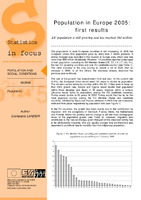Statistics in Focus: Population and social conditions. Population in Europe 2005: first results
| dc.contributor.author | Eurostat |
| dc.date.accessioned | 2020-09-29T17:52:38Z |
| dc.date.available | 2020-09-29T17:52:38Z |
| dc.date.issued | 2006 |
| dc.identifier.uri | https://ketlib.lib.unipi.gr/xmlui/handle/ket/2904 |
| dc.description | Downloaded from EU Bookshop |
| dc.description | http://aei.pitt.edu/id/eprint/85587 |
| dc.description.abstract | The population in most European countries is still increasing. In 2005 the European Union (EU) population grew by more than 2 million persons. A similar increase was recorded in the Council of Europe area, which now has more than 808 million inhabitants. However, 14 countries reported a decrease in their population, including six EU Member States (DE, EE, LV, LT, HU, PL), the two EU acceding countries and one EU candidate country (see Table 1). The latter (Croatia) is the only country to record a fall in 2005 after an increase in 2004; in all the others, the decrease already observed the previous year continued. |
| dc.format.extent | 12p. |
| dc.language.iso | en |
| dc.publisher | Statistical Office of the European Communities and Social Statistics |
| dc.subject | Demographics Community |
| dc.subject | Births Resume |
| dc.title | Statistics in Focus: Population and social conditions. Population in Europe 2005: first results |
| dc.type | working document |
| dc.publisher.place | Luxembourg |

